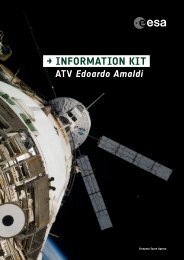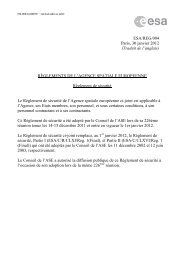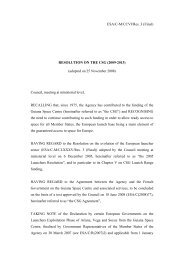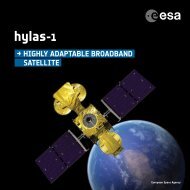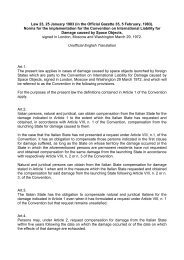→ GSTP ANNUAL REPORT 2011 - ESA
→ GSTP ANNUAL REPORT 2011 - ESA
→ GSTP ANNUAL REPORT 2011 - ESA
Create successful ePaper yourself
Turn your PDF publications into a flip-book with our unique Google optimized e-Paper software.
<strong>→</strong> Core TeChnoloGiCAl elemenTS for<br />
oPTiCAl ATomiC CloCkS<br />
<strong>ESA</strong> is enhancing its support to scientific and technological developments<br />
in key aspects of Optical Frequency Metrology and Optical<br />
Atomic Frequency Standards. This is with a view to applying these<br />
developments to meet future requirements of Space Missions, where<br />
the required levels of stability and accuracy exceed the theoretical<br />
limits of the highest performance microwave atomic clocks. Atomic<br />
Clocks in the optical domain have today already experimentally surpassed<br />
microwave clock performance both in fractional frequency<br />
instability and inaccuracy.<br />
The overall goal of the activity is the developmental support for the<br />
preparation of sub-system elements of an Optical Atomic Frequency<br />
Standard (OAFS), flight demonstrator, meeting a predefined specification<br />
and flight envelope in Space in the coming decade.<br />
The activity was formulated to be conducted in 3 phases. Phase 1<br />
was initiated in <strong>2011</strong> with two parallel contracts with the participation<br />
of DE, UK, IE, FR, AT and CH.<br />
Each contractor proposed a different implementation approach leading<br />
to a different frequency standard. The possibilities that are being<br />
considered are broadly divided into:<br />
(a) A laser cooled neutral atom (“Lattice Clocks”)<br />
(b) A single laser cooled trapped ion (“Ion Clocks”)<br />
Lattice Clocks offer the prospect of high frequency stability, as a<br />
consequence of their superior Signal to Noise Ratio (SNR), over Ion<br />
Clocks at short timescales (1 second) whilst the single trapped ion,<br />
being essentially isolated from the surrounding environment represents,<br />
in principle and in practice, the most accurate optical frequency<br />
standard. The architecture and operation of a single ion<br />
lattice Clocks Approach<br />
> Neutral Strontium Lattice development<br />
> Compact Sr + Trap<br />
standard is the least complex of (a) and (b) above and, consequently,<br />
offers the prospect of the development of a more compact optical<br />
atomic frequency standard for space operation.<br />
It also offers the possibility to be even further simplified, and even<br />
scaled down from its current system dimensions, with the implementation<br />
of micro integration technology which has been developed<br />
in the micro-electronics industry.<br />
There are several sub-system elements that, in total, comprise a<br />
complete OAFS or clock technology and the exact description of<br />
these elements depends entirely on the clock (system) chosen. The<br />
key sub-systems of an Optical Atomic Clock include three principal<br />
elements:<br />
1. A Physics Package (PP) which will provide the trapped Ion/<br />
Atom source (and isotope) and will thus define the interrogation<br />
wavelength<br />
After<br />
and<br />
the<br />
spectral<br />
successful<br />
conditions.<br />
flight qualification<br />
2. Cooling<br />
of<br />
&<br />
PLs<br />
auxiliary<br />
and manufacturing<br />
lasers, which will<br />
of the<br />
be developed with clear<br />
goals for the<br />
vehicle<br />
achievement<br />
subsystems,<br />
of an<br />
2010<br />
appropriate<br />
was<br />
spectral performance<br />
with optimization<br />
mainly<br />
for<br />
devoted<br />
the space<br />
to the<br />
environment.<br />
vehicle<br />
3. Ultra narrow<br />
integration<br />
linewidth,<br />
and equipment<br />
frequency stabilized Local Oscillator.<br />
In terms<br />
testing.<br />
of the probe laser development/Optical Local Oscillator<br />
(OLO), the principal challenges to be addressed are the achievement<br />
of ultra-narrow laser linewidth







